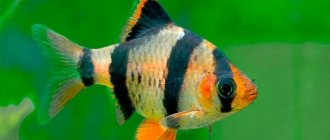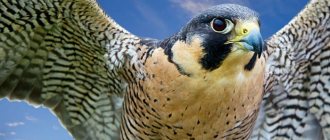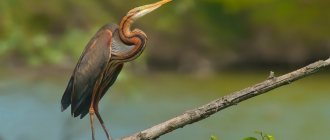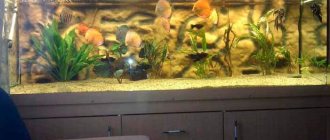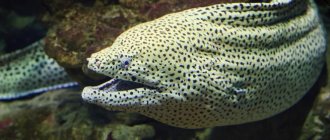Peculiarities
In most cases, these are large aggressive creatures with a strong hunting instinct. They will be happy to enjoy not only a piece of fresh meat delicacy served, but also to hunt for their neighbors. Some breeds eat only self-caught food, i.e. they need to be provided with constant natural floating food.
Predatory fish include several families. It is not entirely correct to classify this or that phenotype as completely carnivorous.
Predators require the presence of plant foods in their diet, from which they obtain vitamins and nutrients, just as any herbivorous fish eats protein foods of animal origin (bloodworms, tubifex, etc.).
Considering that predatory fish are massive specimens, they will need a large living area, which must be equipped with cleaning systems and special equipment, as well as finding a suitable place in the room.
Caring for carnivores is a labor-intensive and costly process. The decision to purchase such breeds should be well-informed and very responsible.
The exception is the red parrot, an attractive fish with a bright orange color. The variety was bred artificially and is distinguished by its comparative simplicity of maintenance. The color ranges from light yellow to rich orange. To prevent the color from losing its brightness, parrot fish in the aquarium are fed with food containing carotenoids.
Other varieties for the aquarium
Now a few words about less popular predatory fish for the aquarium.
Piranha
Belongs to the Cyprinidae, lives in the Amazon and African rivers. It grows up to 30 cm, the sides are slightly flattened, and are distinguished by large, sharp teeth. The color is dark gray, the red belly is especially popular, with a bright red tint in the lower part of the body. Kept in flocks, preferably kept in a species tank. Piranha feeds on small fish, beef, and worms.
Knife fish
Another name is Black Knife. The narrow and elongated body of a bluish-black hue fully justifies this name. The above breed does not have a dorsal fin or scales. Belongs to the electric family. Its habitat is the basin of the Amazon and Parana rivers. Can reach up to half a meter in length. Lives at the very bottom, hiding in thickets of algae, feeding only on live food.
Snakehead
The order Perciformes, the habitat is very wide - from India and Congo to China and Siberia. It got its name because of its elongated body and voluminous scales on its head. The color is brown and gray, grows on average up to 30 cm. A special feature of snakeheads is the ability to breathe atmospheric oxygen.
Anabas
The second name is slider. She received this nickname for her ability to crawl not only on land, but also through trees, in search of better conditions. Lives in southern Asia and the Philippines. The body shape is similar to cichlids. The color ranges from green to brown, the body is intersected by several vertical stripes. When kept in an aquarium, it is necessary to maintain a significant distance from the water level to the glass lid.
Tetraodon
An unusual breed from the four-toothed family. The habitat is similar to Anabas. It has an ovoid body shape and modest dimensions for a carnivore - up to twenty centimeters. It has no scales, but is equipped with many sharp spines located on the back and abdomen. When there is danger, it swells up like a balloon. Color is brown or green with dark spots, the belly is much lighter.
Clarid catfish
Found in Asia and Africa. The body of this catfish is eel-like, the fins are long, and the pectoral fins are equipped with large spines. The color of the skin is grayish-brown. Domestic clarius reaches 70 cm. They are night hunters, strong and pugnacious. Compatible only with representatives of larger varieties.
Crescent-tailed barracuda
Comes from the rivers of the South American continent. The body is long, up to 27 cm, the fins are sharp. The color is pinkish-gray. It feeds exclusively on fish. One of the easiest predators to keep, it has a relatively peaceful character. Requires a lot of space and freedom of movement.
Sacbranch catfish
Lives in south-eastern waters of Asia. In captivity, its height reaches 35 cm. The colors are dark gray, brown and albino. The body shape and movements of this catfish resemble a snake. It has thick mustaches on its head and poisonous spines on its fins. They like to lie on the bottom, in thickets or snags.
Shilb striped
Range – western part of Africa. The height of the shilba can reach 30 cm. It belongs to the catfish, has an elongated body and mustache. The pectoral fins of the shilba are saturated with poison. The color is brownish or gray, with horizontal stripes of a silvery tint. Not too aggressive, needs a large and long aquarium.
Belonesox
Decorative pike is viviparous. It lives in the waters of Mexico and Nicaragua. It grows up to 20 cm, with females being much larger. It is very elongated in length, the color is brown, with a green-bronze sheen. Swims near the surface, does not collect food from the bottom. Females are extremely quarrelsome and can pose a serious danger even to their own species.
Polypterus
It is found on the algae-overgrown bottom of water bodies in Africa and India. The serpentine body of Polypterus ends with a large head. The color is yellowish-gray. Its dimensions do not exceed 90 cm. It has an unusual serrated fin on its back. Breathes oxygen at the surface of the water.
Golden Leopard
From the genus of cichlids, lives in the African Lake Malawi. Grows up to 25 cm, the coloring of this cichlid resembles the skin of a giraffe - dark markings on a yellow background. Requires a tank volume of at least 500 liters. The golden leopard is kept in a group of a male plus several females; the presence of other males, or individuals of other breeds will lead to clashes.
Silver Aravana
Range: large rivers of South America. It has impressive dimensions - about 120 cm. A pronounced predator, it hunts all living things that are smaller in stature. The silver color of the Aravana's scales changes with age in different shades - from reddish to blue. It should be noted in the content that the Aravana often jumps to the surface for prey.
Toadfish
Lives in the waters of the Pacific and Atlantic oceans, from the coast of Australia to Thailand. Approximately 30 cm in length, a third of the body is occupied by a huge head, the entire skin is covered with asymmetrical growths and equipped with spikes with poison. Its color ranges from yellow to dark beige, with black random patterns. Likes to hide in plants and rocks at the bottom.
Exodon paradoxical
It lives in the Brazilian and Guyanese parts of the Amazon. It got its name for its strange behavior: despite its gregarious nature, exodon is quite aggressive, and its small size (10 cm) does not stop it from attacking larger representatives of the underwater world. The color of the exodon is silver, the fins are reddish, and there are black markings on the side and at the tail.
Carapace
Another name is armored pike, or alligator. The scientific name of the class is Atractosteus. Found in water bodies of the North American continent. The smallest type of carapace reaches a length of about 80 cm. Its body is covered with hard scales, its color is olive-brown with a pattern of diamond-shaped scales. The carapace leads a sedentary lifestyle.
Freshwater Garfish
Or needlefish. Found in Asian and Indian rivers and the Black Sea. It has a narrow, long body of a greenish-silver hue and a height of up to 30 cm. The teeth of the Sargan are very sharp, so you should be careful with it. Sometimes it jumps out of the aquarium, so it's worth using a lid.
Vampire fish
In another way - Payara. Range: South America. It got its name because of its teeth, which are at least 15 cm long. Payara’s body is oval in shape, greenish-gray in color. In captivity it reaches 75 cm. It is extremely difficult to maintain and rarely lives longer than three years. Prefers strong currents.
Aristochromis Christie
Found in Malawi. Height is 30 cm, the color of males is blue, females are grayish, both have a black horizontal stripe along the entire body. Prefers sandy soil and rocks at the bottom. Harems contain a male plus three or four females. If there is significant free space, it gets along peacefully with larger breeds.
Trahira (wolf fish)
Found in South American waters. It grows up to 50 cm and is distinguished by a very large head with a powerful jaw. Grayish scales with ink splashes can change tone depending on age and area of residence. Trahira is able to get along with large, peaceful neighbors.
Popular types
The most popular varieties of such unusual aquarium fish include the following.
Aravana
An ancient aquarium predator, dating back about 25 million years. It lives in South American reservoirs and has a massive, elongated and laterally flattened body. Length - up to 1 meter, weight - up to 5 kg, covered with large scales of silver-beige or silver-pink tint. It can jump high out of the water column after prey and is very aggressive. It feeds on mollusks, small fish, frogs, arthropods, insects and even small birds and reptiles.
Aravana is an ancient aquarium predator, dating back about 25 million years.
Astronotus
Astronotus auratus is an oval-shaped cichlid native to Venezuela, which is very popular due to its variety of colors: multi-colored spots or scales on a dark background, creating intricate patterns. The phenotype reaches 35 cm and is known for its aggressiveness. For two astronotuses you will need a housing with a capacity of 350-400 liters. It feeds on animal food, but will not refuse fruit.
Pineapple or creeper
Beautiful predatory aquarium fish Anabass (Climb family) are freshwater inhabitants with a bony skeleton and a laterally flattened body, the size of which reaches 22 cm.
The color of the Pineapple is gray-beige with a greenish tint. At the same time, the back is darker, and the belly is yellowish.
An interesting feature of the species is the ability to live outside a body of water for several days. These fish are quite jumpy and can crawl on land. Therefore, be sure to cover the aquarium so that you don’t have to look for your pets throughout the apartment.
The Crawler's diet should consist of small fish, fry, and boiled rice. This is a school predator that is comfortable in a family of 4–5 individuals. In this case, the aquarium should have a volume of 150 - 200 liters.
Other types
In addition to the above, there are other equally attractive predatory fish for the home aquarium.
Common swordmouth (Khudzhet's pike)
An aggressive representative of characins, native to South America. Outwardly it resembles a European pike, has small silvery scales and a characteristic small black spot at the base of the tail. In captivity it reaches 25-30 cm, in nature it is 2-3 times larger. It feeds on any animal food, including bloodworms, earthworms, fry, pieces of fish fillet, shellfish and meat.
Snakehead
A true predator, both in nature and in captivity, is the snakehead.
In its natural habitat, the snakehead eats all the fish it can handle. It has the unique ability to breathe atmospheric oxygen. The head of the fish is covered with snake-like scales, and the body is elongated. For these qualities it received the name snakehead.
Conditions of detention:
- constant access to the surface of the water for breathing;
- soft and neutral or acidic water is recommended (5.0-7.0 pH)
- It is better to use gravel as a soil; sand is not the most suitable covering for the bottom, since snakeheads often make sharp throws and stir up the substrate;
- Shelters in the form of underwater trees and above-water vegetation are required.
Feeding is carried out mainly with live food, but it is permissible to feed with earthworms, shrimp, and fish meat.
There are 3-4 species of snakeheads in total, the most popular in the aquarium hobby are the following:
- golden cobra or orange-spotted;
- red;
- dwarf;
- imperial;
- rainbow;
- jar;
- luxurious;
- chevron;
- African;
- ocellated.
All species differ not only in appearance, but also in the requirements for the conditions of their detention.
Compatibility
A species aquarium is the best option for keeping carnivores. However, there are often clashes within the species, for example, over territory or during spawning. Crookshanks also attack each other out of hunger.
Under no circumstances should you add small fish, otherwise they will simply become live food for “meat eaters.” Large herbivores can be added to some varieties so that they do not become prey for hunters.
Some species prefer solitary living, while others are kept only in groups.
Apteronotus white-bordered
Apteronotus are distinguished by a large (up to 50 cm) body with an elongated shape. In appearance, they resemble a well-fed snake, the body of which is compressed laterally and narrowed in the direction from the head to the tail.
This species has no scales, and the protective function is performed by mucus, which is abundantly secreted by the skin.
With an average size of 30 - 35 cm, Apteronotus can show aggression even towards larger brothers. Especially if they begin to lay claim to their territory. An aquarium for such inhabitants should be purchased at the rate of 200 liters for each individual.
Apteronotus are natural hunters who react to various living creatures (fish, crustaceans, freshwater shrimp). But you can also offer them finely chopped squid meat.
Growing conditions
Keeping predatory breeds requires certain skills and compliance with rules.
Aquarium
There are special requirements for an aquarium for predatory fish:
- The vessel is placed in a well-lit place, carefully monitoring its cleanliness. The water must be enriched with oxygen, and a filter and aerator must be installed.
- The volume of the dwelling is determined based on living conditions, the size of pets and their number, but not less than 50 liters per specimen. The larger and more aggressive the breed, the more space is required.
The volume of water for predatory fish must be at least 50 liters per individual
- The home is decorated with driftwood, stones, caves and algae, and natural vegetation with wide leaves and strong roots is planted.
- Small fish other than those intended for food are not added to meat-eaters.
Safety precautions must be observed. It is forbidden to immerse a hand with injuries or wounds inside a tank with predators - this will provoke them to attack.
Temperature
The average ambient temperature for live swallows is 24-27 degrees. The value of the indicators is determined depending on the specific breed of the pet. Most of them are inhabitants of tropical waters and require constant maintenance of heat. They cannot tolerate temperature changes. Cohabitation of cold- and heat-loving phenotypes is unacceptable.
Filtration and aeration
An aquarium with carnivores must have a powerful filter. Leftover meat food quickly decomposes in a warm environment, releasing ammonia that is dangerous to fish. And they themselves emit a considerable amount of waste.
Powerful aeration is also important. It helps to enrich the water area with oxygen, as well as reduce the concentration of harmful impurities.
An aquarium with carnivores must have a powerful filter.
Nutrition
Feeding pets is done taking into account their needs. Regardless of the chosen method of feeding, the best food for live swallows will be meat, fish fillets, shrimp, shellfish, worms, bloodworms, tubifex, brine shrimp and other protein foods. Real hunters are given the opportunity to catch their prey on their own by throwing live fish into a container.
Species that swallow prey whole are fed 2-3 times a week. The rest - a couple of times a day. If the feeding mode is set incorrectly, hungry individuals will begin to eat each other.
Features of reproduction
During the breeding season, the aggressiveness of predators is maximum. Therefore, a pair of future parents are placed separately two weeks before spawning. After fertilization, the male is returned back, otherwise he may be eaten by the partner.
Most predatory cichlids incubate their eggs in their mouths. Having laid out the eggs, the female releases the babies, after which she is removed. The fry are fed live dust, daphnia, brine shrimp and cyclops, sorting the fry as they grow.
Caring for aquarium predators is incredibly difficult. They require large habitat areas, expensive food, modern equipment, regime and maintenance of clear water parameters. Many of them are poisonous, bloodthirsty and dangerous to humans. However, if all rules and regulations are observed, carnivorous pets will become the real pride of their owner.
Have you kept predatory fish in an aquarium? What kind was this? Share life hacks based on its content with beginners.
Tetraodon
A representative of the four-toothed family is distinguished by a large head with large eyes and a body shaped like an egg.
Tetraodon has no fins on its belly, and each scale has a prickly spine at the tip. This aquarium predator is quite a rare species, which has an amazing ability to protect itself and a daring character. Tetraodon, with sharp and strong bone plates in the oral cavity, is capable of crushing the shells of oysters and clams, which are its main food. And strong pectoral fins allow them to overtake prey with lightning speed. Tetraodon has the most powerful defense mechanisms:
- he is able to inflate like a balloon;
- spines on the scales rise in case of danger;
- the muscles and gonads contain a strong poison that paralyzes the enemy who wants to eat it.
It is better not to keep tetraodons in an aquarium with other types of fish. Predators in an aquarium can be aggressive even with their own relatives.
The genus Tetraodon has more than a hundred species, differing in conditions of detention and temperament. In captivity, only 10 representatives of the genus feel well. The most famous are the following:
- figured;
- green;
- red-eyed;
- Thai;
- tetraodon mbu;
- red;
- leopard print
Conditions of detention:
- when keeping a school of fish in a species aquarium, you should provide shelter for each;
- thermal regime – 22-26°C;
- change water every week by 20% of the volume;
- the lighting is not bright, close to natural;
- feeding is carried out exclusively with meat foods (live food, liver, beef).
Shellfish should definitely be included in the diet. Tetraodons not only eat their meat, but also wear down their ever-growing dental plates in their mouths.
Krenicichla cordis punctata
This is a predator from the Cichlid order that is not too demanding in terms of living conditions, capable of growing up to 24 cm. Its favorite food is small live fish, tadpoles, worms, and fresh beef.
A pair of Crenichl feels comfortable in a container of 400 liters or more. These are quite angry and very active representatives of their species, who require a lot of space for games and chasing prey. In a cramped aquarium, there is a danger of injury to fish, which during the hunt often crash into decorative elements of the reservoir.
Spotted Indian knife
The fish, which has such an unusual name, is quite large, by aquarium standards, in size and has an evil character. Often its victims are relatives who have encroached on “foreign” territory.
The lifestyle of this predator is nocturnal, so it should be fed in conditions of minimal illumination of the reservoir. The diet of the Indian Knife may include tadpoles, small fish, and fry. Its size reaches 30 cm, so the capacity should not be less than 150 - 200 liters for each individual.
So that the fish can hide somewhere during the day, the bottom of the aquarium is equipped with grottoes, driftwood, and ceramic pots.
Reproduction
Aggressive attacks towards others in predatory fish intensify during the spawning period. To reduce the intensity of passions, the couple is placed in a separate container.
The diet of future parents should include more protein foods.
The birth of fry can be expected after 1 – 2 weeks. At the same time, some types of fish can show aggression towards their offspring, so they are immediately placed in a common aquarium.
Sacbranch catfish
The size of this fish can reach 28–30 cm. It has a brown–gray “camouflage” color, although there are also albinos bred through selection.
Catfish have 4 pairs of whiskers located on their muzzle as a kind of “radar” for searching for prey (small fish) among rocky soil.
The bites of this predator are poisonous and can cause anaphylaxis, so contact with it should be done with extreme caution.
To keep one catfish you will need a container of 150 liters.
Red piranha
Widely known for its predatory nature, the fish has a round, laterally flattened body that tapers towards the tail. It has a dark gray color with a multi-colored tint.
Among aquarists, these fish are popular because of their unusual, “fierce” appearance, which arises from the sharp triangular teeth and protruding lower jaw.
The predatory Piranha is a “collective” fish that feels comfortable only in a school. Therefore, the “dwelling” for this species is chosen to be spacious.
You can use chopped fresh or frozen poultry as feed. Live small fish are fed to predators from time to time.
A hungry Piranha is capable of attacking members of its own species, so you should not limit its amount of food.
What to look for when breeding predatory aquarium fish
- Choosing the size of the aquarium: you need to look at the body size of the fish: predators grow up to 35-50 cm in length, and they certainly shouldn’t be cramped, which means the size of the tank should be large.
- The ability to arrange the aquarium so that there are both highly lit and dark places. To do this, you can use all kinds of driftwood or other decorative elements.
- Particular attention is paid to the choice of “neighbors”. Predatory aquarium fish will not tolerate smaller fish around unless they are potential food for them. It is important to understand that the diet must be complete and varied, because in a bad case it may happen that the fish begin to gnaw each other’s fins.
- The ability to provide the temperature required for a certain type.
- Continuous supply of oxygen to the water, and most importantly, the presence of a filter and clear water.

